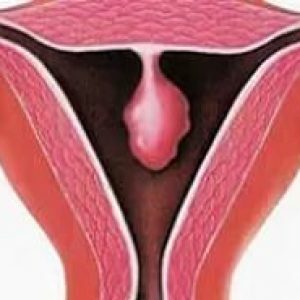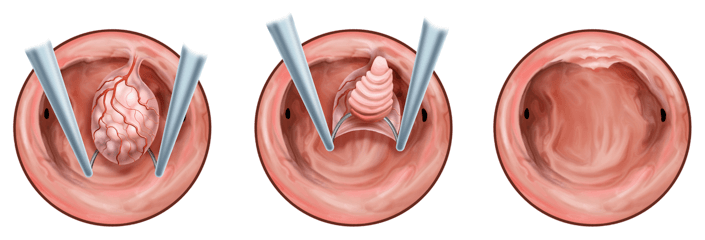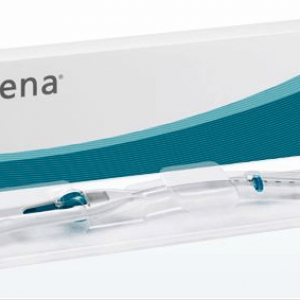Endometrial polyps: symptoms, diagnosis and treatment

Benign formation, which is formed from the basal layer of the endometrium in the uterus, in medicine is classified as an endometrial polyp.This disease can occur at any age of the woman, but more often polyps are diagnosed in patients over the age of 35 years.
Table of contents: Clinical picture of endometrial polyps Treatment of endometrial polypsDoctors can not clearly identify the reasons for the appearance of this benign formation, but can identify several predisposing factors:
- abortion, spontaneous abortions, complicated labor( for example,After them, blood clots or fragments of the placenta remained in the uterus - eventually they are replaced by a connective tissue and a polyp is formed);
- disorders in the process of hormone production - the level of progesterone is lowered, and the level of estrogen is increased;
- endocrine disruption - diabetes mellitus, thyrotoxicosis;
- trauma of the uterine cavity - diagnostic curettage( frequent), abortion, wearing an intrauterine device for a long time;
- hypertension;
- obesity.
Clinical picture with endometrial polyps
If the benign tumor under consideration is small, then symptomatology will be absent.Most often, such polyps are diagnosed accidentally, when a woman is being examined by ultrasound of the pelvic organs. If the size of the lesion is large, or if several polyps occur, the following symptoms may be present:
- Menstrual irregularities.They manifest bloody discharge from the vagina between menstruation, in young women, such discharges can be of a profuse nature, but in the menopause period, single discharges are more often noted.
- Cramping pains in the lower abdomen.They can not be associated with anything, but women note that this symptom appears during or immediately after the end of sexual intercourse.
- Contact bleeding.So called spotting immediately after intercourse.
Note: infertility is diagnosed in women of reproductive age against the background of the existing endometrial polyp.Many doctors do not associate these two problems, but it was noted that after the removal of the benign tumor under consideration, the probability of conception increases dramatically.

The clinical picture of the endometrial polyp is not characteristic, the above symptoms are inherent in both uterine myoma and inflammatory process in the endometrium.If a woman observes the appearance of these signs, she should go to the gynecologist - the doctor only after a full examination of the patient will be able to diagnose and prescribe an effective treatment.
Treatment of the endometrial polyps
Diagnosis of the benign neoplasm in question is usually not difficult for the doctor - it is enough to make the patient an ultrasound examination of the pelvic organs.
The primary method of treating endometrial polyps is surgery, when the neoplasm is simply removed from the uterine cavity.This operation is called hysteroscopy, it is carried out with the help of a special tool - a hysteroscope inserted into the uterine cavity.In the process of working the surgeon examines the cavity of the uterus and removes the polyp.It is mandatory during the operation to scraped endometrium - this biomaterial is sent to the laboratory for histological examination, which makes it possible to determine the type of polyp.

In the future, the tactics of treatment depends on the type of polyp and the age of the patient.If the histological examination showed that the neoplasm has a fibrous structure, then no therapy is performed.In the case of detection of glandular fibrous or glandular polyps, the patient will display hormonal therapy that will normalize and stabilize the menstrual cycle and the overall hormonal balance in the body.
Hormonal therapy is a long-term course( from 3 to 6 months), the doctor prescribes, as a rule, certain drugs:
- Yarina, Zhanin, Regulon - estrogen-gestagen contraceptives, which are excellent for women younger than 35 years;
- Dufaston, Utrozhestan are gestagens, they are usually prescribed as postoperative therapy for women over 35 years of age;
- intrauterine system "Mirena" - it releases the hormone levonorgestrel into the uterine cavity, is put to women who do not plan a pregnancy in the next 5 years.
 It is worth paying special attention to one point: if the adenomatous form of the polyp has been revealed during histological examination of the biomaterial, radical treatment will be required, since this form of polyps is considered a precancerous condition.If a woman is already 45 years old, doctors perform a full removal of the uterus, in the case of a combination of the disease in question with endocrine disorders, it is recommended that removal and appendages be performed.Women who are of reproductive age will have to undergo a long course of hormone therapy, which will allow them to become mothers, but at the onset of the menopause, doctors will insist on prompt treatment.
It is worth paying special attention to one point: if the adenomatous form of the polyp has been revealed during histological examination of the biomaterial, radical treatment will be required, since this form of polyps is considered a precancerous condition.If a woman is already 45 years old, doctors perform a full removal of the uterus, in the case of a combination of the disease in question with endocrine disorders, it is recommended that removal and appendages be performed.Women who are of reproductive age will have to undergo a long course of hormone therapy, which will allow them to become mothers, but at the onset of the menopause, doctors will insist on prompt treatment.
Endometrial polyps, at first glance, are absolutely safe formations.But a woman should remember that in the confluence of certain circumstances such a benign formation can become malignant.Therefore, if you have even minor health problems in the gynecological plan, you need to contact a gynecologist who can diagnose the problem on time and prescribe an effective, low-traumatic treatment.
Tsygankova Yana Aleksandrovna, medical reviewer, therapist of the highest qualification category

